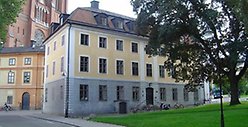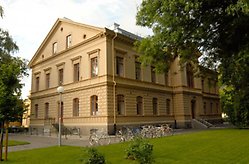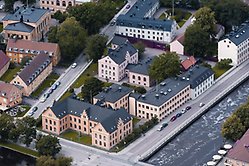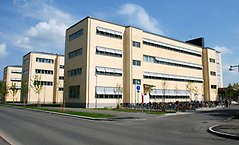History of the Psychology Subject and the Department of Psychology at Uppsala University
The development of psychology as an independent subject was slow in Sweden. Although the first Swedish psychology laboratory was set up at Uppsala University in 1902 by Sidney Alrutz, for decades it was not connected with a professorship or a department of psychology. Alrutz started his work at a department of physiology within the faculty of medicine, and psychology later got its home at the Department of Education. Alrutz gave courses in experimental psychology within this academic discipline but he was never awarded a permanent position.

Ekermanska huset (Photo: SFV)
An independent department of psychology in Sweden was not established until 1948, when Uppsala got a professorship in psychology, nearly seven decades after Wundt started his laboratory in Leibzig. The first Swedish professor in psychology was Rudolf Anderberg who, before the establishment of psychology, was professor at the Department of Education. He did research within several areas of psychology, such as the psychology of work, individual differences, and classical psychophysics.
The appointment of Gunnar Johansson as professor of psychology in 1957 meant the beginning of a new era for psychology at Uppsala. As a founder of event perception research, Johansson was an internationally well-known person and he started a vigorous research program on problems in visual space and motion perception which attracted many graduate students. Although ground research was his main interest, Johansson was also very active in applied research, especially concerning perceptual aspects of road traffic.

Regnellianum
Partly overlapping in time with Johansson, Ingemar Dureman was appointed in 1969 at the Department of Psychology as professor of psychology, especially applied psychology, which for his part included clinical as well as physiological and pharmacological research. Dureman was also very active in promoting the profession of clinical psychology in close co-operation with colleagues in psychiatry. A large number of students were attracted by
Dureman's research areas in order to be either researchers or applied psychologists.

Kvarteret Munken
In order to organise the studies and examination of professional psychologists a so called department group had been formed in 1971. It consisted of teachers from the departments representing the core areas of the program: psychology, education and sociology. In 1977, this department group was organised as a department of its own called the Department of applied psychology. Dureman's professorship was transferred to this department. This meant that until recently there were two departments of psychology at Uppsala university with both overlapping and special duties.
Before Dureman was appointed full professor, there had been, in accordance with the Swedish tradition, only one full professor at the department; with his appointment the number grew to two. The low number meant that the research at the department was dominated by the full professors and the graduate students associated with them. The scene changed during the 1970:s when the number of students grew rapidly and many new teachers were appointed, mainly so-called "universitetslektorer" (usually translated "associate professors"), a unique Swedish university teacher category with a heavy teaching load but also, to varying degrees, with possibilities to do research. A few new full professors were also appointed at the two departments.
While some of the new appointees continued to do research within Johansson's and Dureman's areas: visual space and motion perception, clinical psychology, or physiological psychology; others investigated areas such as animal psychology, psychology of emotions, judgements under uncertainty, dynamic decision theory, moral development, work organisation, perceptual skill and skill acquisition, haptic perception, aids for the severely visually impaired, olfactory perception, music psychology, developmental psychology, health psychology, test theory, unconscious perception, personality, and social psychology.
See the pages under Research for a the wide variety of present research at the department.

Blåsenhus, Norbyvägen-Plantskolegr.
The two psychology departments, having co-operated especially in teaching during the period of separate existence, were fused to one Department of psychology in 1996. In 2010 the department moved to the new Campus Blåsenhus.
